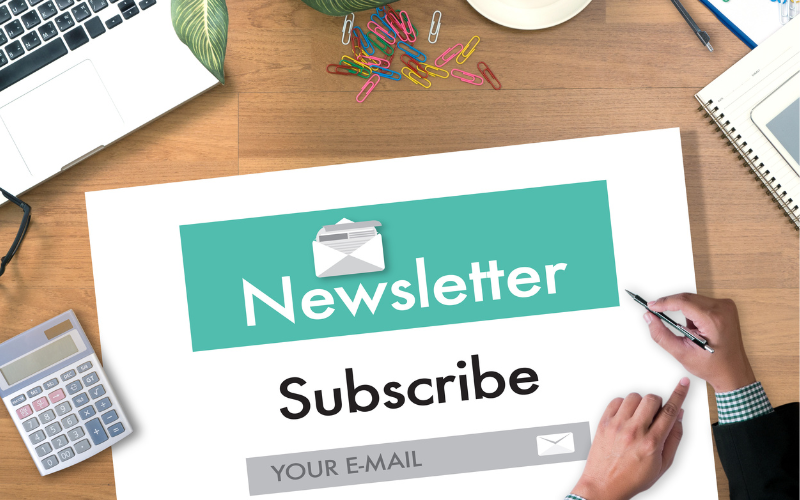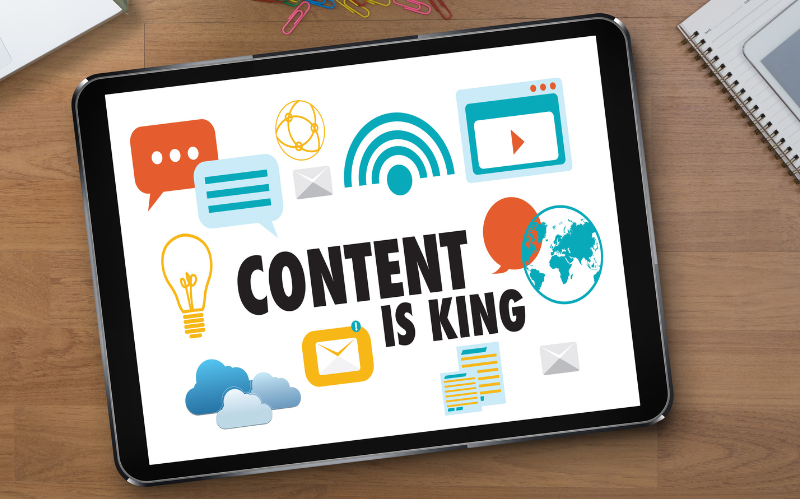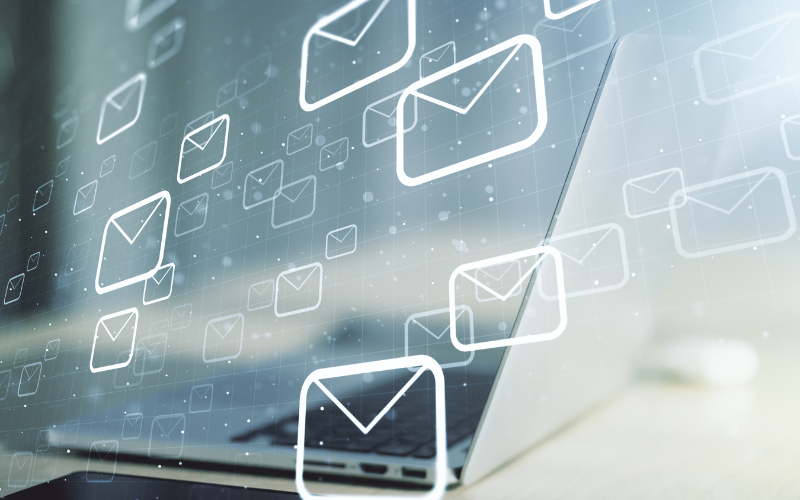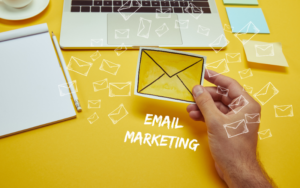Email marketing is a popular digital marketing technique employed by businesses to communicate with their customers, share information about products and services, and engage with their target audience. This approach allows companies to send tailored emails to a group of subscribers, with the aim of achieving various marketing goals.
Table of Contents
key aspects to consider when implementing email marketing:
- Building an Email Subscriber List: The foundation of email marketing lies in creating a list of email addresses from individuals who have given explicit permission to receive emails from your business. Maintaining a high-quality email list is essential for the success of your email marketing campaigns.
- Segmentation: Email lists can be divided based on various criteria, such as demographics, purchasing history, behaviour, and more. Segmentation enables you to send content that is relevant to specific groups of subscribers, thereby increasing the effectiveness of your campaigns.
- Content Creation: The content of your emails should be engaging, valuable, and pertinent to your audience. This may include promotions, newsletters, product updates, educational materials, and other relevant content.
- Design and Layout: Emails should be visually appealing and easy to read on different devices. Utilize responsive design to ensure that your emails display properly on both desktop and mobile platforms.
- Personalization: Personalizing emails by including the recipient’s name or other pertinent information can significantly boost open and click-through rates. Personalization extends beyond using the recipient’s name; it’s about delivering content that matches their interests and needs.
- Timing and Frequency: The timing and frequency of your emails can impact their effectiveness. Experiment with different sending times and frequencies to determine what works best for your target audience.
- Call to Action (CTA): Each email should contain a clear and compelling call to action. Whether it’s encouraging a purchase, inviting subscribers to a webinar, or directing them to read an article, your CTA should be prominently featured and easy to follow.
- Testing and Optimization: Continuously test various elements of your emails, such as subject lines, content, images, and CTA buttons, to identify what resonates most with your audience. Employ A/B testing to compare different email versions.
- Compliance: Ensure that your email marketing practices adhere to applicable laws and regulations, such as the CAN-SPAM Act in the United States or the GDPR in Europe. This encompasses obtaining consent for sending emails, providing a simple unsubscribe option, and including your physical mailing address in each email.
- Analytics and Tracking: Utilize email marketing software to track campaign performance. Monitor metrics like open rates, click-through rates, conversion rates, and unsubscribe rates to evaluate the effectiveness of your emails and make data-driven improvements.
- Automation: Email marketing automation enables you to establish automated email sequences based on user actions, streamlining lead nurturing and long-term customer engagement.
- Spam Avoidance: Refrain from engaging in spam-like practices, such as sending unsolicited emails, using misleading subject lines, or inundating emails with excessive promotional content. These actions can harm your sender reputation and impact email deliverability.
Email marketing serves as an effective means to connect with your audience, boost sales, and cultivate brand loyalty when executed correctly. Staying updated with industry trends and adhering to best practices is essential to maximize the advantages of this marketing channel.
Building an email subscriber list
Building an email subscriber list is a crucial step in email marketing. A high-quality and engaged subscriber list can be a valuable asset for your business. Here are steps to effectively build and grow your email subscriber list:
- Opt-In Forms: Place opt-in forms strategically on your website and landing pages. These forms should be easy to find and use. Consider using pop-up forms, slide-ins, or static forms in prominent locations.
- Landing Pages: Create dedicated landing pages for specific offers or promotions. Landing pages are often more effective at converting visitors into subscribers because they focus on a single call to action.
- Offer Incentives: Encourage sign-ups by offering incentives like discounts, free trials, downloadable resources, or exclusive access to content. Make sure the incentive is relevant to your target audience.
- Segmentation: Allow subscribers to choose their preferences and interests during the sign-up process. This helps with list segmentation, allowing you to send more targeted and relevant content.
- Social Media Promotion: Promote your email sign-up forms on your social media profiles and posts. Use compelling calls to action (CTAs) and visuals to attract attention.
- Referral Programs: Implement referral programs where existing subscribers can refer friends or colleagues in exchange for rewards or incentives.
- Contests and Giveaways: Organize contests or giveaways that require participants to subscribe to your email list for a chance to win prizes.
- Guest Blogging: Write guest posts for other websites or blogs in your industry. Include a bio or author section that encourages readers to subscribe to your email list for more content.
- Webinars and Events: Host webinars, workshops, or virtual events related to your niche. Promote these events through email and encourage participants to subscribe for future updates.
- Networking: Attend industry events, conferences, and trade shows to network and collect email addresses from interested parties. Make sure to ask for permission before adding them to your list.
- Email Signature: Include a sign-up link in your email signature. This can be a simple and effective way to gain subscribers from your everyday email communications.
- Customer Feedback Surveys: Send surveys to your customers and include an option to subscribe to your email list for updates and special offers.
- Content Upgrades: Enhance your blog posts with content upgrades – additional resources that readers can access in exchange for their email addresses. For example, if you write a blog post about “10 Tips for X,” offer a downloadable PDF with “20 Advanced Tips for X” in exchange for an email sign-up.
- Paid Advertising: Use paid advertising campaigns on platforms like Facebook, Google Ads, or LinkedIn to drive traffic to your landing pages and encourage email sign-ups.
- Email Forwarding: Encourage your current subscribers to forward your emails to their friends and colleagues who might be interested, with a clear call to action to join your list.
- Quality Over Quantity: Focus on attracting subscribers who are genuinely interested in your content or products. High-quality subscribers are more likely to engage and convert.

Remember that building an email subscriber list is an ongoing process. Continuously engage with your subscribers, provide value, and maintain list hygiene by regularly cleaning out inactive or disengaged contacts. Over time, a well-nurtured email list can become one of your most valuable marketing assets.
Creating effective email content
Creating effective email content is essential for a successful email marketing campaign. Whether you’re sending newsletters, promotional emails, or transactional messages, the content you create should engage your audience, drive action, and deliver value. Here are some tips for email content creation:
- Start with a Strong Subject Line:
- Craft a compelling subject line that piques the recipient’s interest and encourages them to open the email.
- Use personalization, urgency, or curiosity to make the subject line stand out.
- Keep it concise and relevant to the email’s content.
- Use a Clear and Engaging Email Body:
- Write a concise and engaging introduction that provides a preview of what’s inside the email.
- Organize your content with clear headings, subheadings, and bullet points to make it easy to read.
- Maintain a conversational tone that resonates with your audience.
- Keep paragraphs and sentences short for better readability.
- Use visuals, such as images and videos, to complement your text when appropriate.
- Segment Your Email List:
- Tailor your email content to different segments of your audience based on their preferences, behaviour, and demographics.
- Send personalized content that speaks to the specific interests and needs of each segment.
- Offer Value and Benefits:
- Clearly communicate the value and benefits of your product, service, or offer to the recipient.
- Highlight how your offering can solve their problems or fulfil their needs.
- Include customer testimonials or case studies to build credibility.
- Include a Clear Call to Action (CTA):
- Every email should have a single, clear, and compelling CTA that tells the recipient what action to take.
- Use action-oriented language in your CTA, such as “Shop Now,” “Subscribe Today,” or “Learn More.”
- Make your CTA button visually distinct with contrasting colours.
- Mobile Optimization:
- Design your email content to be mobile-responsive. Many people check their emails on smartphones.
- Use a responsive email template to ensure your content looks good on all devices.
- A/B Testing:
- Experiment with different elements of your email content, such as subject lines, CTAs, images, and copy.
- Conduct A/B tests to determine which variations perform best and optimize your future emails based on the results.
- Personalization:
- Incorporate personalization in your emails, addressing recipients by their first name and tailoring content to their previous interactions and preferences.
- Personalized emails tend to have higher engagement rates.
- Create a Sense of Urgency:
- Encourage immediate action by using words like “limited time offer,” “exclusive deal,” or “act now.”
- Highlight expiring discounts or promotions to motivate recipients to take action.
- Optimize for Spam Filters:
- Avoid spammy words and phrases that can trigger spam filters.
- Use a recognizable sender name and email address.
- Include an unsubscribe link and physical address in compliance with email marketing regulations.
- Testing and Preview:
- Before sending your email, use email testing tools to check how it appears in various email clients.
- Preview your email on different devices to ensure it looks and functions as intended.

Remember that effective email content is not only about promoting products or services but also about building and nurturing relationships with your subscribers. Provide value, maintain consistency, and adapt your content strategy based on recipient feedback and performance data.
A/B testing
A/B testing, also known as split testing, is a method used in marketing and website optimization to compare two versions of a webpage, email, or other marketing materials to determine which one performs better. It helps businesses make data-driven decisions by testing changes or variations and understanding their impact on user behaviour and conversion rates. Here’s how A/B testing works and some best practices:
How A/B testing works:
- Hypothesis: Start by formulating a hypothesis about a change you want to test. This could be anything from a different headline, call-to-action (CTA) button colour, email subject line, or webpage layout.
- Split the Audience: Divide your audience into two equal and random groups. One group (A) is exposed to the original version (control), and the other group (B) sees the variation (test).
- Implement Changes: Apply the specific change or variation you want to test to group B. For example, if you’re testing a new CTA button colour, group B will see the webpage or email with the new colour, while group A sees the old one.
- Data Collection: As users interact with both versions, collect relevant data, such as click-through rates, conversion rates, bounce rates, or any other metrics that align with your goals.
- Statistical Analysis: Use statistical analysis to determine if the variation (group B) outperforms the control (group A) in a statistically significant way. This means the results aren’t due to chance but indicate a genuine difference.
- Draw Conclusions: Based on the analysis, you can draw conclusions about which version performed better and why. Did the change improve or hurt your desired outcome?
- Implement Winning Variation: If the variation proves to be more effective, implement it as the new standard. If not, you can try a different variation or go back to the original.

Best practices for A/B testing:
- Set Clear Goals: Define specific, measurable goals for your A/B test. Know what you want to achieve, whether it’s higher conversion rates, more clicks, longer session durations, or something else.
- Test One Variable at a Time: To isolate the impact of a change, test only one variable at a time. This ensures that the results are attributed to that specific change.
- Random Sampling: Ensure that the audience is divided randomly and equally between the control and test groups. This reduces bias in the results.
- Adequate Sample Size: Ensure you have a sufficiently large sample size to obtain statistically significant results. Small sample sizes can lead to unreliable outcomes.
- Run Tests for a Sufficient Duration: Run the test for a long enough period to account for variations in user behaviour over time. Seasonal or weekly fluctuations can affect results.
- Segmentation: Consider segmenting your audience based on demographics or behaviour to understand how different groups respond to changes.
- Continuous Testing: A/B testing is an ongoing process. Continuously test and optimize to improve your results over time.
- Learn from Failed Tests: Not all tests will yield positive results. Even failed tests provide valuable insights that can inform future experiments.
- Keep Records: Maintain a record of your A/B tests, including hypotheses, results, and changes made. This documentation helps in building a knowledge base for your marketing efforts.
- Don’t Assume: A/B testing is about gathering data, not making assumptions. Trust the data, even if it challenges your initial beliefs.
A/B testing is a powerful tool for improving the effectiveness of your marketing campaigns, websites, and other digital assets. By systematically testing variations and learning from the results, you can make informed decisions that lead to better user experiences and higher conversions.
Email marketing automation
Email marketing automation is the use of technology and automated processes to send targeted and personalized emails to subscribers at specific times or in response to specific actions. It streamlines email marketing campaigns, increases efficiency, and allows businesses to engage with their audience in a more personalized and timely manner. Here are key aspects of email marketing automation:
- Subscriber Segmentation: Automation platforms allow you to segment your email list based on various criteria such as demographics, behaviour, purchase history, and engagement level. Segmentation enables you to send tailored content to different groups, improving relevance and engagement.
- Welcome Series: Automated welcome emails are sent to new subscribers as soon as they join your list. These emails introduce your brand, set expectations, and provide valuable information or incentives to encourage engagement.
- Drip Campaigns: Drip email campaigns are a series of automated emails sent at predefined intervals. They nurture leads, provide educational content, and guide subscribers through the customer journey.
- Abandoned Cart Recovery: E-commerce businesses can automate emails to remind customers about abandoned shopping carts and encourage them to complete their purchase.
- Triggered Emails: Triggered emails are sent in response to specific actions or events, such as a website visit, a download, a purchase, or a form submission. These emails are highly relevant and timely.
- Personalization: Email marketing automation platforms allow you to personalize emails by including the recipient’s name, product recommendations, and other relevant content. Personalization can significantly boost engagement and conversion rates.
- A/B Testing: Automation tools often include A/B testing features that let you test different email elements like subject lines, content, and CTAs to determine what resonates best with your audience.
- Behavioural Tracking: Advanced automation platforms track user behaviour on your website or within emails. This data can be used to trigger specific emails or to tailor content to individual preferences.
- Lead Scoring: Automation allows you to assign scores to leads based on their behavior and interactions with your emails and website. High-scoring leads are prioritized for more targeted marketing efforts.
- Reporting and Analytics: Automation tools provide detailed analytics on email performance, including open rates, click-through rates, conversion rates, and more. Use this data to measure the success of your campaigns and make data-driven decisions.
- Integration: Many email marketing automation platforms integrate with other software and tools, such as CRM systems, e-commerce platforms, and analytics tools, allowing for a seamless flow of data and information.
- Compliance: Ensure that your email automation practices comply with relevant laws and regulations, such as the CAN-SPAM Act or GDPR. This includes obtaining consent for sending emails and providing an easy way to unsubscribe.
- Lifecycle Marketing: Automation can be used throughout the customer lifecycle, from lead generation to post-purchase engagement and customer retention.
- Customer Retention: Automated email campaigns can be designed to keep existing customers engaged, gather feedback, and encourage repeat purchases.

Email marketing automation can save time, improve the customer experience, and drive better results for your business. By leveraging automation tools and strategies, you can deliver the right message to the right person at the right time, ultimately increasing engagement and conversion rates.
In conclusion, email marketing automation is a game-changer for businesses looking to streamline their communication, nurture leads, and enhance customer relationships. It empowers marketers to deliver highly personalized and timely messages, resulting in increased engagement and conversion rates.
By utilizing segmentation, welcome series, drip campaigns, and triggered emails, you can effectively guide your audience through their unique customer journeys. The power of automation lies in its ability to send the right message to the right person at precisely the right moment, whether it’s a welcome email for new subscribers or a cart abandonment reminder for potential customers.
Moreover, automation platforms offer invaluable tools like A/B testing, behavioural tracking, and lead scoring, allowing you to continuously optimize your email campaigns for better results. You can gain deeper insights into your audience’s preferences and behaviour’s, enabling you to tailor your content and offers for maximum impact.
However, it’s crucial to remember that successful email marketing automation goes hand in hand with compliance and ethical practices. Always obtain proper consent from your subscribers, offer clear unsubscribe options, and adhere to relevant data protection laws.
In the ever-evolving arena of digital marketing, email automation remains a potent tool for businesses of all sizes. It not only saves time and resources but also enables you to build stronger customer connections, boost sales, and achieve your marketing goals efficiently.
So, whether you’re a small start-up looking to nurture leads or a well-established enterprise aiming to enhance customer loyalty, email marketing automation can be a strategic asset in your marketing toolkit. Embrace the power of automation, personalize your emails, and watch as your campaigns soar to new heights, forging lasting relationships with your audience along the way.




